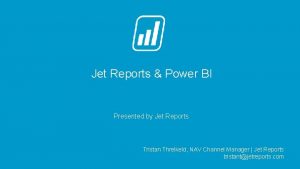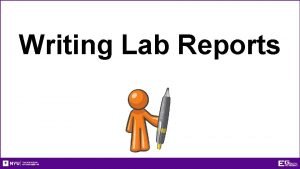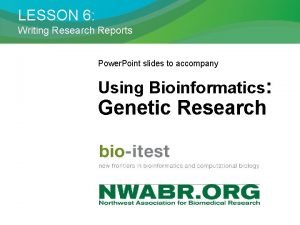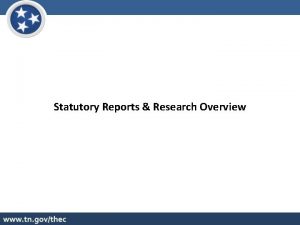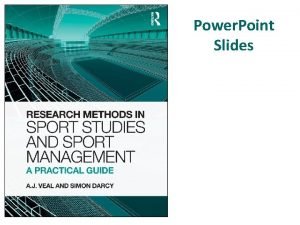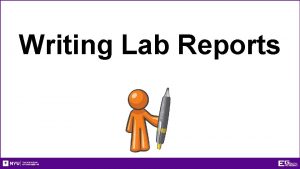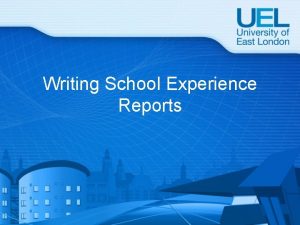LESSON 6 Writing Research Reports Power Point slides











- Slides: 11

LESSON 6: Writing Research Reports Power. Point slides to accompany Using Bioinformatics: Genetic Research Chowning, J. , Kovarik, D. , Porter, S. , Grisworld, J. , Spitze, J. , Farris, C. , K. Petersen, and T. Caraballo. Using Bioinformatics: Genetic Research. Published Online October 2012. figshare. http: //dx. doi. org/10. 6084/m 9. figshare. 936568

Science and Technical Writer Kris Freeman Place of Employment: School of Forest Resources, University of Washington Type of Work: Science and Technical Writing I think we live in a time when people are overwhelmed by data, and the job of a good editor or writer is to help your reader deal with a particular set of complex data, to make it understandable. Not all scientists know how to convey their data, so your job is to help them convey this information.

Scientific Practices Ask a Question Based on Observations: Plants grow in soil. What do plants use to grow larger? Hypothesis & Prediction: If – and – then Hypothesis: Plants use materials in the soil to gain mass. Prediction: If my hypothesis is correct, and I measure the mass of soil and plants over time, then I predict the soil mass will decrease as plant mass increases. Gather and Analyze Data (Methods): Measure mass of bean seeds and soil at Day 1 and Day 15. Results: Bean plants increased in mass by 24. 6 grams. Soil mass stayed the same. Conclusions: Minerals from the soil do not affect the mass of plants. Hypothesis is contradicted. New Hypothesis: Plants use something in the air to gain mass. Images Source: Wikimedia Commons.

Key Sections for a Research Report Example Title Introduction Methods Results Discussion

Introduction • Purpose of study: – Research question and hypothesis • A brief background: – Organism(s) you are working with (common and scientific names), habitat – What you hoped to find – Use your knowledge of the organism(s) you studied. • Use reference materials: – Wikipedia (www. wikipedia. org) – Encyclopedia of Life (www. eol. org) Example The purpose of this study was to compare the sequence similarity between the H 5 N 1 virus and the H 1 N 1 virus. We hypothesized that the two viruses would be highly similar based on the following characteristics… Avian influenza (AI) is caused by highly pathogenic H 5 N 1 and can be found in such species as Canada geese (Branta canadensis)…. Avian influenza (AI) became a significant human and animal health issue when H 5 N 1 virus was isolated from geese in China (Smith, 2007). Our goal was to evaluate the sequence differences between the H 5 N 1 viruses and the H 1 N 1 virus.

Methods: What Did You Do? Example • What data you collected or what gene(s) you studied and why • What bioinformatics tools you used and why • What analyses you performed and why We collected genomic samples from three different H 5 N 1 viruses isolated from geese. . We used BLAST to perform a multiple sequence alignment of all H 5 N 1 genomic sequences including reference H 1 N 1 virus sample as an outgroup. A phylogenetic tree was drawn from the alignment of the H 5 N 1 genomic sequence and reference H 1 N 1 virus sample as an outgroup. The tree suggested the phylogenetic relationship between the viruses was…

Results: What Did You Find? Example • What you found: – Describe your sequence alignment and your phylogenetic tree. – Be sure to label each figure. The phylogenetic tree showed that the H 1 N 1 reference strain was closest evolutionarily to the H 5 N 1 chicken strain… Figure 1: Phylogenetic tree of genomic sequences from three H 5 N 1 viral strains and the H 1 N 1 reference strain.

Discussion: What Does it Mean? Example • Your interpretations and conclusions about your data. • Relate your interpretations back to your original hypothesis. Do you need to revise your original hypothesis? • What would you do next? What would be a good follow-up experiment? We found that the H 5 N 1 chicken strain had the greatest similarity to H 1 N 1… We had originally hypothesized that the H 1 N 1 virus would be highly similar to all H 5 N 1 viral strains. We found that H 5 N 1 sequences were more diverse than previously expected. In our future work, we plan to sequence a larger number of H 5 N 1 and H 1 N 1 influenza isolates to evaluate the degree of diversity between these two viruses.

References • Include the references used when writing the report. • The format is called the Modern Language Association or MLA format. – Example 1: To cite a magazine article like “Scanning Life” from Lesson Two, the MLA format would look like this: Kunzig, Robert. "Scanning Life. " National Geographic May 2010. Print. – Example 2: To cite the information from electronic sources, like the Encyclopedia of Life website, the MLA format would look like this: Paddy Patterson, Cynthia Parr, Tanya Dewey. Editors. "Homo sapiens Linnaeus, 1758". Encyclopedia of Life. Accessed 22 Jul 2010 from: http: //labs 1. eol. org/pages/4454124.

Science and Technical Writer Kris Freeman Place of Employment: School of Forest Resources, University of Washington Type of Work: Science and Technical Writing I think we live in a time when people are overwhelmed by data, and the job of a good editor or writer is to help your reader deal with a particular set of complex data, to make it understandable. Not all scientists know how to convey their data, so your job is to help them convey this information.

CAREERS IN SPOTLIGHT: Science and Technical Writing What do they do? Science and Technical Writers edit and format complex scientific reports, in collaboration with other scientists. Some Science and Technical Writers also communicate complex research findings to the public and to the media using language and terms everyone can understand. What kind of training is involved? Many have a Bachelor’s degree in English, Journalism, or Technical Writing, and a minor in Biology or a related science. What is a typical salary for a Science and Technical Writer? Varies with experience, and ranges from $30, 000/year ($14/hour) to $90, 000/year ($43/hour). Source: National Institutes of Health, Office of Science Education.
 Difference between formal and informal reports
Difference between formal and informal reports A small child slides down the four frictionless slides
A small child slides down the four frictionless slides Energy conservation quick check
Energy conservation quick check Real power formula
Real power formula Powerbi in powerpoint
Powerbi in powerpoint Point point power
Point point power Jet reports dashboard
Jet reports dashboard Purpose of writing reports
Purpose of writing reports Writing and completing reports and proposals
Writing and completing reports and proposals Reports and proposals
Reports and proposals Penulisan laporan singkat
Penulisan laporan singkat Solar power satellites and microwave power transmission
Solar power satellites and microwave power transmission






